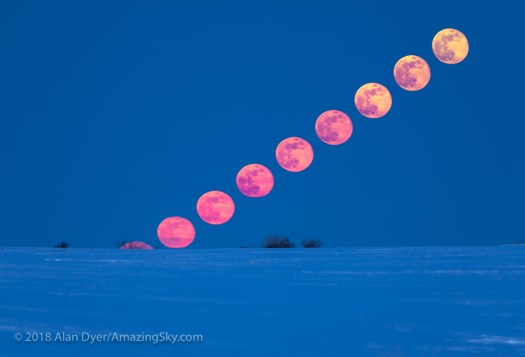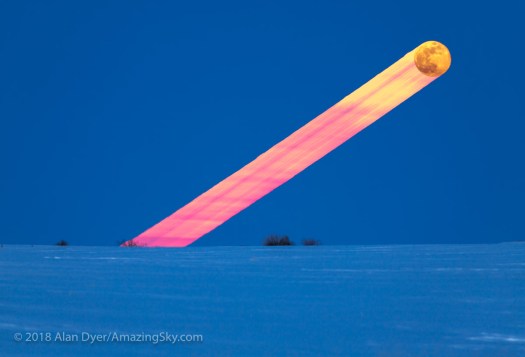
A clear day on Easter Eve allowed me to photograph the setting Full Moon in the morning and the rising Full Moon in the evening.
This was another of the year’s special Full Moons, and this time for a valid historical reason.
This was the “paschal” Full Moon, the one used to determine the date of Easter. It was the first Full Moon after the vernal equinox. The first Sunday after that Full Moon is Easter. This year, the Moon was full about an hour before sunrise on the morning of Saturday, March 31. Easter was the next day, Sunday, April 1.
Below is the view of the Full Moon not long after it was officially Full, as it was setting into the west as the first rays of sunlight lit the foreground at dawn on March 31.

To be precise, the actual paschal Full Moon is a fictional or calculated Moon that occurs 14 days into the lunar cycle, and isn’t an observed Moon. But this year, we really did have a Full Moon just before Easter Sunday, and on the first day of Passover, from which we get the term “paschal.”
Later on March 31, after sunset, the Moon was now half a day past Full, causing it to rise a good half hour after sunset. However, the lighting and sky colour was still good enough to place a reddened Moon rising into a deep blue sky for a wonderful colour contrast.
This was also touted as a “blue Moon,” as it was the second Full Moon in March, and it was also the second blue Moon of 2018. (January had one, too.) But as you can see the Moon was hardly “blue!” It was a fine pink Moon.

The above image is a little fun with Photoshop, and stacks hundreds of images of the rising Moon to create a “Moon trail,” showing the change in colour of the Moon as it rose.
This short HD movie includes two versions of the full time-lapse sequence:
• One showing the Moon rising normally, though the sky and ground come from the first image in the sequence.
• The second is another bit of Photoshop fun, with the Moon leaving disks behind it as it rose.
For the technically minded, I created both movies using Photoshop’s video editing capabilities to layer in various still images on top of the base video file. The stills are layered with a Lighten blend mode to superimpose them onto the background sky and video.

While Easter is a spring holiday, it hardly seems spring here in Alberta. The coldest Easter weekend in decades and lots of snow on the ground made this a winter scene.
With luck, spring will arrive here well before the next Full Moon.
— Alan, April 3, 2018 / © 2918 Alan Dyer / amazingsky.com


Hi Alan,
I have enjoyed your Easter Moonrise videos. Beautiful !
If you do this again some evening, it would be neat to track the Moon (effectively holding the camera fixed in space, except for the slight eastward orbital drift of the Moon) so that the video shows what is really happening, namely it is Earth’s rotation that animates the scene: the eastern horizon with its layers of absorbing atmosphere is tilting down toward the lower-left, revealing the Moon.
But, more work for you in setting up an equatorial mount, and you will need multiple exposures of a darkening horizon and a brightening Moon, while adjusting for the limited dynamic range of a CMOS chip . . . 😦
Roy
Great idea Roy. It’s on the shot list. Maybe this full Moon.
Cool! (sorry, for the weather reference) You always make an interesting, unusual presentation. Thanks for the Photoshop explanation.
Love the streaky moon Alan! 🙂 Wonderful idea to do a ‘moon trail’, …really shows the colour changes/ gradient (of a rising moon) well.
Like the time lapse too, however wasn’t sure if you’d noticed there is a ghost moon image in the first version? (The red moon cresting the horizon, however this might be from a base image, if so it’s there by necessity!)
Anyway, great work – and as always inspiring! 🙂
Julian.
Late spring or early Easter?